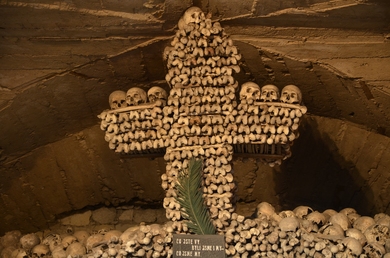Historie kostnice
ve třech jazycích
Mělnická kostnice patří spolu se sedleckou u Kutné Hory k největším v České republice. Je umístěna v kryptě pod presbytářem proboštského kostela sv. Petra a Pavla. Podle postupu stavby presbytáře a nápisu na jejich stěnách sloužila svému účelu do 30. let 16. století.
Kolem kostela byl od nepaměti hřbitov, který však nestačil zejména při morových epidemiích pojmout četné pohřby, a proto hrobníci vybírali pozůstalé kosti a rovnali je v kostnici. Kostnice neboli karnery bývaly u většiny farních chrámů, kde existovaly hřbitovy. Mělnická kostnice sloužila svému účelu do roku 1775, kdy byl hřbitov u kostela zrušen.
Podle guberniálního nařízení ze dne 16. srpna 1787 měly být kosti z kostnic pohřbeny do země. Na Mělníce to však vyřešili zazděním oken a vchodu do kostnice. Hřbitov byl přenesen ke kostelu sv. Ludmily na předměstí.
Při opravách chrámu v letech 1891 – 1892 byl vchod do kostnice znovu otevřen a náhrobní kameny kryjící okna byly přemístěny do interiéru kostela. Po restauraci chrámu z let 1913 – 1916 začal odborně studovat a uspořádávat kosti umístěné v kostnici antropolog světového věhlasu MUDr. RNDr. h. c. Jindřich Matiegka, profesor Karlovy univerzity. Po usilovné práci v době první světové války připravil se dvěma mladými pomocníky (jedním byl jeho pozdější nástupce prof. MUDr. Jiří Malý) kostnici pro studijní účely i pro návštěvy z řad veřejnosti.
V kostnici jsou umístěny pozůstatky asi 10 000 až 15 000 osob různého stáří, pohlaví i etnického původu. Byly sem totiž v minulosti sváženy kosti nalezené na různých místech v okolí Mělníka, pozůstatky válečných událostí třicetileté války a dalších šarvátek.
Das Beinhaus in Melnik gehört gemeinsam mit jenem in Sedlec bei Kutná Hora zu den größten in der Tschechischen Republik. Es findet sich unter dem Presbyterium der Kirche St. Peter und Paul. Rund um diese Kirche war im Mittelalter der Friedhof.
Alle Beinhäuser sollten damals vermauert werden. Der Friedhof befand sich dann bei der heiligen Ludmila Kirche in der Vorstadt. Später, im Jahre 1891-92, war Zutritt ins Beinhaus wieder ermöglicht, aber der Zustand des Inneren der Krypta war jammervoll. Erst in den Jahren 1913 – 1916, während der Restaurierung der Kirche, trat der weltberühmte Wissenschaftler, Anthropologe MUDr. h.c. und RNDR. Jindřich Matiegka zum Fachstudium der hiesigen menschlichen Überreste und brachte sie wissenschaftlich in Ordnung.
Nach seiner Schätzung gibt es hier 10.000 bis 15.000 Menschen, die nicht nur aus Melnik und der nahen Umgebung stammten. Es wurden hier auch Ausländer festgestellt (meistens Sachsen und Schweden), die unweit der Stadt als Soldaten im dreißigjährigen Krieg gefallen sind. Ihre körperliche Überreste wurden später hierher gebracht.
Mělník charnel-house, along with the Sedlec one near Kutná Hora, is one of the biggest in the Czech Republic. It is situated in the crypt under the presbytery of the provost church of Saints Peter and Paul. The church was, within living memory, surrounded by a cemetery, which however wasn’t large enough, especially during the plague epidemics, to accommodate the numerous burials and therefore the gravedigger removed the old bones and piled them in the charnel-house.
Mělník charnel-house was used for this until 1775, when the cemetery by the church was abolished. By a governor’s decree of the 16th of August 1787 all the bones should have been buried. In Mělník this was resolved by walling up the charnel-house windows and entrance. The cemetery was transferred to Saint Ludmila’s church in the suburbs.
During the repairs of the Minster in 1891-1892 the charnel-house entrance was reopened and the tomb stones covering the windows moved into the church interior. After the Minster was renovated in 1913-1916 MUDr. RNDr. h. c. Jindřich Matiegk, a world renowned anthropologist and Charles University professor, started his studies and arranged the bones in the charnel-house. After intensive work during World War I he and his two young assistants (one of whom was his future successor MUDr. Jiří Malý) prepared the charnel-house for studies and public visitors.
The charnel-house contains the remains of about 10,000 to 15,000 people of different ages, sex and origins, because in the past bones found in different places of Mělník’s surroundings as well as remains from the thirty-years war and other skirmishes were brought to the charnel-house.


